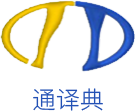


我们矢志于为追求精致英译的翻译员助上一臂之力。集千万句库为你所用,借万千智慧任尔调配,通译句典——为攀登翻译高峰另辟蹊径!
双语句库分类列表:
医学:生理与解剖:

They increase the rate and force of heart contractions, increasing blood output and raising blood pressure.

两者都会使心率加快,心脏收缩率增强,因此使心脏血排出量增加,结果血压上升。

属类:化学及生命科学-医学-生理与解剖

Epinephrine also stimulates breakdown of glycogen to glucose in the liver, raising blood glucose levels, and both hormones increase the level of circulating free fatty acids.

肾上腺素可使肝中贮存的肝糖分解为葡萄糖,结果使血糖升高。两种激素都能增加游离脂肪酸的流通。

属类:化学及生命科学-医学-生理与解剖

All these actions ready the body for action in times of stress or danger, times requiring increased alertness or exertion. Epinephrine is used in medical situations including cardiac arrest, asthma, and acute allergic reaction.

当人在紧张或危险时,即可运用这些额外的葡萄糖和游离脂肪酸作为燃料。肾上腺素可用来治疗心跳停止、哮喘、急性过敏症。

属类:化学及生命科学-医学-生理与解剖

Esophagus :Muscular tube that conveys food by peristalsis from the pharynx to the stomach.

食道:咽与胃之间的直管,藉由蠕动使食物通过。

属类:化学及生命科学-医学-生理与解剖

Both ends are closed off by sphincters (muscular constrictions), which relax to let food through and close to keep it from backing up.

两端均为括约肌所关闭;食物通过括约肌进入食道后,该括约肌立即关闭以防食物向上回流。

属类:化学及生命科学-医学-生理与解剖

Disorders include ulceration and bleeding, heartburn from stomach acid, achalasia (failure of one or both sphincters to open), and muscle spasms. Scleroderma may involve the esophagus.

食道的疾病有溃疡和出血、心口因胃液回流而灼伤、失弛缓症(一端或两端的括约肌无法开启)及肌肉痉挛等。硬皮病也和食道有关。

属类:化学及生命科学-医学-生理与解剖

Excretion: Bodily process for disposing of undigested food waste products and nitrogenous by-products of metabolism, regulating water content, maintaining acid-base balance, and controlling osmotic pressure to promote homeostasis.

排泄:处理未消化食物残渣及代谢之含氮副产物的身体过程,能够调节水分含量,维持酸碱平衡,控制渗透压力,以促进自我恒定性。

属类:化学及生命科学-医学-生理与解剖

It refers to both urination and defecation and to the processes that take place in the digestive and urinary systems, as the kidney and liver filter wastes, toxins, and drugs from the blood and food reaches the last stage of digestion.

排泄意指排尿和排粪,也指消化系统与膀胱内发生的过程--肾和肝从血液中过滤废物、毒素、药物,而食物来到消化的最后阶段。

属类:化学及生命科学-医学-生理与解剖

Ammonia from protein digestion, the primary excretory product, is converted to urea to be excreted in urine.

蛋白质消化所致的氨(主要的排泄物)被转化为尿素(urea)而从尿(urine)中排出。

属类:化学及生命科学-医学-生理与解剖

Face: Front part of the head, extending from the forehead to the chin and housing the eyes, nose, mouth, and jaws.

面:头的前部,从额头到下巴,包括眼睛、鼻子、嘴巴和颚。

属类:化学及生命科学-医学-生理与解剖
| 1 | 两者都会使心率加快,心脏收缩率增强,因此使心脏血排出量增加,结果血压上升。 | They increase the rate and force of heart contractions, increasing blood output and raising blood pressure. | |
| 2 | 肾上腺素可使肝中贮存的肝糖分解为葡萄糖,结果使血糖升高。两种激素都能增加游离脂肪酸的流通。 | Epinephrine also stimulates breakdown of glycogen to glucose in the liver, raising blood glucose levels, and both hormones increase the level of circulating free fatty acids. | |
| 3 | 当人在紧张或危险时,即可运用这些额外的葡萄糖和游离脂肪酸作为燃料。肾上腺素可用来治疗心跳停止、哮喘、急性过敏症。 | All these actions ready the body for action in times of stress or danger, times requiring increased alertness or exertion. Epinephrine is used in medical situations including cardiac arrest, asthma, and acute allergic reaction. | |
| 4 | 食道:咽与胃之间的直管,藉由蠕动使食物通过。 | Esophagus :Muscular tube that conveys food by peristalsis from the pharynx to the stomach. | |
| 5 | 两端均为括约肌所关闭;食物通过括约肌进入食道后,该括约肌立即关闭以防食物向上回流。 | Both ends are closed off by sphincters (muscular constrictions), which relax to let food through and close to keep it from backing up. | |
| 6 | 食道的疾病有溃疡和出血、心口因胃液回流而灼伤、失弛缓症(一端或两端的括约肌无法开启)及肌肉痉挛等。硬皮病也和食道有关。 | Disorders include ulceration and bleeding, heartburn from stomach acid, achalasia (failure of one or both sphincters to open), and muscle spasms. Scleroderma may involve the esophagus. | |
| 7 | 排泄:处理未消化食物残渣及代谢之含氮副产物的身体过程,能够调节水分含量,维持酸碱平衡,控制渗透压力,以促进自我恒定性。 | Excretion: Bodily process for disposing of undigested food waste products and nitrogenous by-products of metabolism, regulating water content, maintaining acid-base balance, and controlling osmotic pressure to promote homeostasis. | |
| 8 | 排泄意指排尿和排粪,也指消化系统与膀胱内发生的过程--肾和肝从血液中过滤废物、毒素、药物,而食物来到消化的最后阶段。 | It refers to both urination and defecation and to the processes that take place in the digestive and urinary systems, as the kidney and liver filter wastes, toxins, and drugs from the blood and food reaches the last stage of digestion. | |
| 9 | 蛋白质消化所致的氨(主要的排泄物)被转化为尿素(urea)而从尿(urine)中排出。 | Ammonia from protein digestion, the primary excretory product, is converted to urea to be excreted in urine. | |
| 10 | 面:头的前部,从额头到下巴,包括眼睛、鼻子、嘴巴和颚。 | Face: Front part of the head, extending from the forehead to the chin and housing the eyes, nose, mouth, and jaws. |
 查询记录
查询记录




